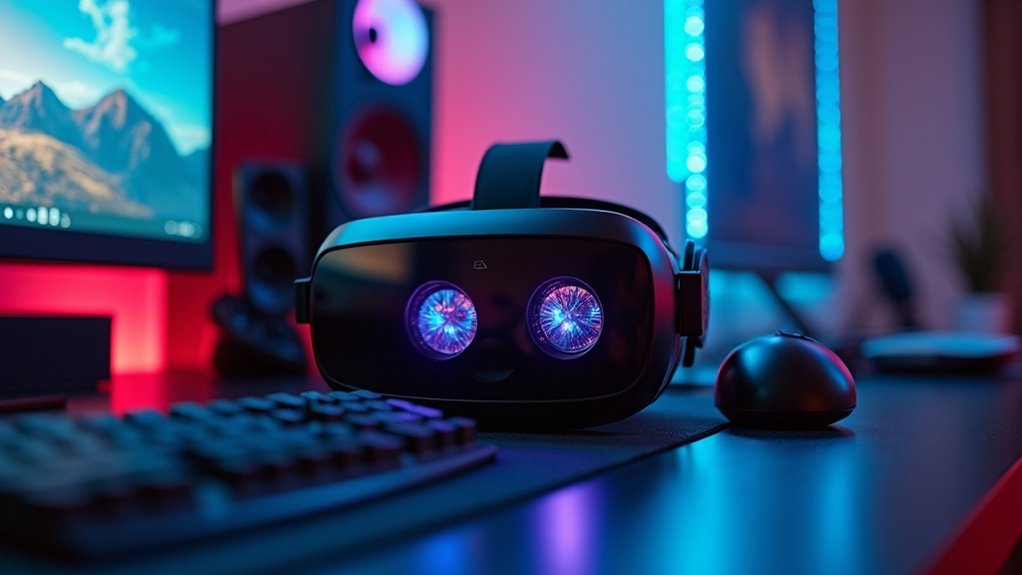You’ll find the perfect FOV for VR gaming typically falls between 80-110 degrees, with most gamers discovering their sweet spot around 80-85% FOV. This range balances immersion with visual clarity while preventing motion sickness and maintaining ideal performance. Your individual head shape, facial structure, and hardware capabilities will influence your ideal setting. Fast-paced games benefit from wider FOV around 110 degrees, while simulation games work best at 90-100 degrees for enhanced detail and cockpit readability. Fine-tuning these settings reveals your system’s full potential.
Understanding Field of View in VR Gaming

Your virtual reality headset’s field of view determines how much of the digital world you’ll see at any given moment. FOV measures the angular width of your visual experience, typically ranging from 90 to 110 degrees in most VR headsets. High-end models can exceed 120 degrees for enhanced immersion.
A wide FOV eliminates the restrictive “tunnel vision” effect that plagues narrower displays. You’ll experience more of the virtual environment simultaneously, creating that vital feeling of being truly “inside” the game world rather than peering through a window.
However, FOV isn’t just about maximizing width. The best setting balances immersion with comfort, as excessively narrow or wide views can trigger motion sickness.
Your personal head shape and facial structure also influence how you perceive FOV, making individual testing essential for finding your perfect setting.
How FOV Affects Gaming Performance and Frame Rates
When you increase your VR headset’s field of view, you’re demanding markedly more processing power from your GPU and CPU to render those additional pixels and wider viewing angles.
This increased workload directly impacts your frame rates, forcing you to make essential trade-offs between visual immersion and smooth performance.
Your optimization settings become vital in this balancing act, as pushing FOV too high without proper adjustments can lead to stuttering, frame drops, and the dreaded motion sickness that ruins your gaming experience.
Hardware Resource Demands Increase
While a wider field of view dramatically enhances your VR immersion, it comes at a steep cost to your system’s performance. Your graphics card must render considerably more pixels as you increase FOV settings, creating exponentially higher demands on processing power. This increased workload can push even high-end hardware to its limits, potentially causing frame drops that’ll ruin your smooth experience.
You’ll need to carefully balance FOV expansion with your system’s capabilities. Most hardware performs best when Field of View stays between 80-110 degrees, preventing the stuttering and inconsistent rendering that destroys immersion.
If you’re experiencing performance issues, reducing FOV settings often provides immediate relief, allowing your system to maintain the critical high refresh rates that VR gaming demands for comfort and visual clarity.
Frame Rate Trade-offs
Because VR gaming demands sustained frame rates of at least 90 FPS to prevent motion sickness and maintain comfort, you’ll face critical decisions when adjusting FOV settings that directly impact your system’s ability to meet these requirements.
When you push FOV beyond 110 degrees, your hardware must render considerably more pixels, creating substantial graphical load that can drop frame rates below ideal thresholds. This reduction triggers motion sickness and compromises your gaming experience through blurriness or stuttering.
You can mitigate these challenges using dynamic foveated rendering, which maintains higher frame rates by reducing rendering quality in your peripheral vision while preserving sharp detail where you’re looking.
This optimization technique allows you to enjoy wider FOV without sacrificing performance, creating the perfect balance between immersion and smooth gameplay.
Optimization Settings Impact
Your graphics card’s workload increases exponentially as you expand FOV settings, forcing it to render considerably more pixels across a wider viewing angle that can overwhelm even high-end hardware. Smart optimization becomes essential for maintaining performance while preserving image quality.
| FOV Setting | Performance Impact | Recommended Use |
|---|---|---|
| 70-80% | Minimal strain | Competitive gaming |
| 80-85% | Balanced load | General VR gaming |
| 85%+ | Heavy processing | High-end systems only |
Fixed foveated rendering dramatically reduces peripheral processing demands, letting you push FOV boundaries without frame rate penalties. This technique maintains sharp central vision while reducing detail at your ideal distance from the display edges. You’ll find that adjusting FOV around 80-85% delivers the sweet spot between immersion and smooth performance across most VR titles.
Hardware Limitations and Graphics Card Requirements
When you’re pushing your VR headset beyond the standard 85% FOV threshold, your graphics card becomes the primary bottleneck determining whether you’ll experience crystal-clear immersion or frustrating stutters and blur.
High-end GPUs like the RTX 4090 can handle wider FOV settings while maintaining performance, but lesser cards struggle with the increased rendering demands.
Premium graphics cards deliver smooth VR performance at maximum FOV settings, while budget GPUs force compromises between field of view and frame rates.
Most VR headsets offer 80-110 degree FOV ranges, and achieving ideal performance at maximum settings requires substantial GPU power.
If you’re experiencing blurriness above 85% FOV, you’ll need to either adjust your graphics settings or upgrade your hardware.
Motion reprojection can help compensate for lower frame rates, but balancing FOV with visual fidelity becomes essential for users with mid-range graphics cards seeking smooth gameplay.
The 80-85% FOV Sweet Spot for Most Gamers

Most VR enthusiasts find their perfect balance between immersion and clarity within the 80-85% FOV range, where peripheral vision expands without sacrificing the sharp detail that makes virtual worlds truly convincing.
This sweet spot delivers three key advantages:
- Enhanced readability – You’ll notice cockpit gauges and environmental text remain crisp and legible, especially during flight simulations where detail matters most.
- Optimal performance balance – Even high-end setups with RTX 4090 graphics cards benefit from this range, minimizing performance strain while maximizing visual quality.
- Reduced image degradation – Staying within 85% FOV prevents the blurriness that plagued earlier VR experiences when pushing beyond recommended limits.
Exceeding 85% typically compromises clarity, making cockpit views and detailed environments suffer.
You’ll want to experiment within this range to find your personal comfort zone.
Balancing Image Clarity With Immersion Levels
While the 80-85% FOV range offers exceptional clarity, you’ll need to weigh this sharpness against the immersive pull of wider field-of-view settings that can transform your VR experience.
This trade-off becomes particularly noticeable when you push beyond 110 degrees, where peripheral vision often suffers from blurriness despite enhanced spatial awareness.
You can achieve ideal settings by implementing Fixed Foveated Rendering, which maintains image clarity in your central vision while preserving the immersive benefits of a wider FOV.
Consider your gaming priorities: cockpit simulations benefit from that crisp 80-85% range, while exploration games thrive with expanded perspectives.
Match your FOV settings to your gameplay style: precision cockpit games need crisp clarity while open-world adventures demand expansive immersion.
The key lies in finding your personal balance point where visual fidelity meets environmental immersion without causing eye strain or fatigue.
Cockpit Readability and Text Visibility Considerations

Reading cockpit instruments and interface text becomes your primary concern when diving into flight simulators or racing games, where every gauge and label matters for accurate gameplay.
You’ll face significant readability challenges without constantly moving your head, which disrupts immersion and breaks the gaming flow.
Here’s how to optimize cockpit readability:
- Adjust your field of view to 80-85% – This sweet spot enhances label clarity while maintaining decent external visibility.
- Enable Fixed Foveated Rendering – This focuses processing power on your central vision where text appears sharpest.
- Fine-tune settings based on your hardware – Balance performance with visual clarity according to your VR headset’s capabilities.
Remember that pushing beyond 85% FOV often introduces blurriness that’ll make critical instruments unreadable during intense gaming moments.
Individual Preferences and Hardware Capabilities
Although the 80-85% FOV range works well for many players, your personal sweet spot depends heavily on both your visual preferences and your system’s horsepower.
If you’re running high-end hardware capabilities like an RTX 4090, you can push FOV settings up to 110 degrees without sacrificing image quality. However, lower-end systems may struggle with wider angles, forcing you to prioritize performance over immersion.
Your VR headset also matters greatly. The Valve Index offers adjustable FOV settings, while headsets like the HP Reverb G2 and Meta Quest 3 provide varying ranges.
You’ll need to experiment personally, as some users prefer maximum immersion with wider FOV while others prioritize crystal-clear visuals with narrower settings. Test different configurations to find what works best for your hardware and comfort level.
Popular VR Headset FOV Comparisons
When you’re choosing a VR headset, you’ll find FOV measurements vary dramatically across popular models, from the HP Reverb G2’s modest 90 degrees to the Pimax 5K Plus’s extreme 200-degree range.
You’ll need to balance your desire for immersion against potential performance costs, as wider FOVs often demand more processing power and can introduce visual distortions.
Let’s examine how current headsets stack up and what trade-offs you’ll encounter when prioritizing FOV over other features.
Current Headset FOV Measurements
Today’s VR headsets offer varying Field of View measurements that directly impact your gaming immersion. Most mainstream devices fall within the 80-110 degree range, but each headset delivers a distinct immersive experience.
Here’s how current headset FOV measurements stack up:
- Entry-Level Range (80-105°): The Oculus Quest averages 95 degrees, reaching up to 105 degrees maximum, providing solid immersion for most gaming scenarios.
- High-End Range (100-114°): The Valve Index spans 100-110 degrees, while the HP Reverb G2 reaches 114 degrees, offering enhanced clarity for simulation games.
- Ultra-Wide Range (200°): Pimax headsets like the 8K achieve exceptional 200-degree FOV, though they face image clarity and software stability challenges.
Your choice depends on balancing immersion with visual quality and system reliability.
Performance Versus Immersion Trade-offs
Since VR gaming demands a delicate balance between visual fidelity and immersive presence, you’ll encounter significant trade-offs when choosing between headsets with different FOV capabilities.
Wider FOV enhances immersion by expanding your peripheral vision, making virtual environments feel more natural and increasing your sense of speed and presence. However, this comes at the cost of performance – your system needs more processing power to render additional visual information, potentially impacting frame rates.
You’ll also face clarity compromises. The Valve Index’s 130-degree FOV delivers exceptional immersion but sacrifices resolution clarity compared to the HP Reverb G2’s narrower 114-degree FOV with superior pixel density.
If you’re flying detailed cockpit simulations, you might prioritize clarity over immersion. For racing or action games, wider FOV typically provides better spatial awareness despite potential motion sickness risks.
Optimizing FOV Settings for Different Game Types
Different game genres demand distinct FOV approaches to maximize both performance and comfort in VR.
You’ll need to tailor your settings based on what you’re playing to get the most out of your virtual world experience.
Here’s how to enhance FOV for different game types:
1. Fast-paced action games – Set your FOV around 110 degrees for enhanced spatial awareness.
This wider setting helps you track movement in your peripheral vision, giving you a competitive edge in shooters and combat games.
2. Simulation games – Use a moderate FOV between 90-100 degrees for flight or racing sims.
This prioritizes clarity and detail over peripheral vision, ensuring you can read instruments and environmental details clearly.
3. General VR content – Maintain FOV distance between 1.25-5 meters for ideal comfort and interaction with virtual elements.
Frequently Asked Questions
What Is the Best Setting for VR?
You’ll want to start with FOV settings between 100-110 degrees for ideal immersion and comfort. Adjust based on your preferences – reduce to 80-85% for better instrument readability in detailed cockpit environments.
What Is the Field of View in VR?
You’ll see a field of view ranging from 80-110 degrees in most VR headsets, which determines how much of the virtual world you can observe at once through your device’s lenses.
What Is the Ideal FPS for VR?
You’ll want to maintain 72-90 FPS for ideal VR gaming. Higher rates like 120 FPS work better for fast-paced games, but you should prioritize consistent frame rates over fluctuating higher ones for comfort.
What Are Good Specs for VR Gaming?
You’ll need an RTX 3060 or RX 6700 XT graphics card, 16GB RAM, Intel i5-9600K or Ryzen 5 3600 CPU, and SSD storage for ideal VR gaming performance and smooth experiences.





Leave a Reply